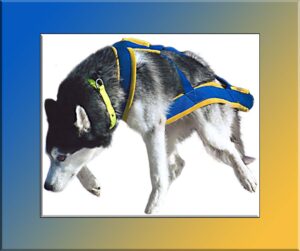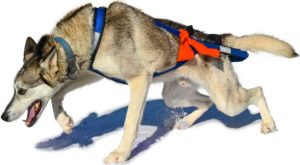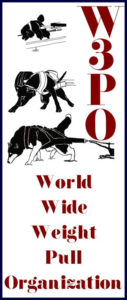Canine Weight Pulling
... A Deeper Dive
History:
Canine weight pulling has a long and working-class history. While the sport itself is relatively new, its roots go back to the late 19th century. Here are some key points:
• Klondike Gold Rush (1896-1899): Strong dogs were essential for hauling supplies and equipment across harsh terrain. Competitions likely arose from miners comparing their dogs' pulling prowess.
• Mail Delivery: Sled dogs were used for mail delivery in remote areas until the 1960s. These dogs needed to be powerful and reliable.
• 1970s: Formalization of the sport began. Organizations like the World Wide Weight Pull Organization (W3PO) and the International Sled Dog Racing Association (ISDRA) developed weight pull competition guidelines. While pulling a weighted cart a distance of 16 feet (within 60 seconds), dogs compete using specialized harnesses and carts, showcasing not only their strength and skill, but also the bond of trust between handler and dog.
🛡️ Molosser and Bully Breeds –
American Staffordshire Terriers, Bulldogs, Mastiffs, American Bullies
Descended from ancient Molosser dogs of Greece and Rome, these powerful breeds were developed for protection, endurance, and determination — traits that make them outstanding pullers today.
🏔️ Working Group Breeds –
Newfoundlands, Bernese Mountain Dogs, Saint Bernards, Siberian Huskies, Alaskan Malamutes These breeds were bred for hauling and rescue work in rugged terrain and harsh climates. From the fishing coasts of Newfoundland to the snowy Alps and Arctic tundra, their strength, stamina, and eagerness to pull are legendary.
❄️ Nordic and Spitz Breeds –
Samoyeds, Greenland Dogs, Canadian Eskimo Dogs Originating from northern peoples who relied on them for travel and survival, these dogs are known for endurance, resilience, and a cheerful willingness to work in extreme cold.
🏅 Modern Working Mixes –
Many of today’s top competitors are mixed-breed working dogs — combining power, agility, and enthusiasm. Success depends more on training, conditioning, and teamwork than on pedigree.
What Makes Them Special:
These breeds possess a unique combination of traits that make them ideal for weight pulling:
• Strength: They have powerful muscles and bone structure for pulling heavy loads.
• Endurance: They can maintain exertion for extended periods.
• Temperament: They are trainable, have a strong work ethic, and enjoy the challenge.
Training:
Training for weight pulling is a gradual process that prioritizes safety and well-being. Here's a basic outline:
• Start Young: Introduce basic pulling exercises in puppyhood, focusing on building muscle and coordination is a key training approach and should proceed in gradual increments. Building familiarity with the feel of the pulling harness and the sounds and feel of having an object behind the puppy, is key to building confidence and fun into weight pulling.
• Positive Reinforcement: Reward desired behaviors and gradually increase weight and distance.
• Conditioning: Regular exercise and proper nutrition are crucial for building stamina and preventing injuries.
• Experienced Trainer: Guidance from a knowledgeable trainer can ensure proper technique and prevent overexertion.
Veterinary Considerations:
• Not All Dogs Are Suited: Breeds with certain body types or health conditions may not be suitable for weight pulling. Brachycephalic breeds (short-nosed) can struggle with breathing during exertion.
• Veterinarian Recommendations: Consulting a veterinarian experienced with working dogs can help determine a dog's suitability and recommend a safe training program.
• Pre-Competition Checks: Pre-competition vet checks ensure the dog is in good health and ready to compete, reducing the risk of injuries.
Organizations and Events:
• The World Wide Weight Pull Organization (W3PO) is a major sanctioning body that establishes guidelines and promotes safe canine weight pulling.
• Regional and National Clubs: Many regions have weight pulling clubs that hold competitions throughout the year. These events provide opportunities for dogs to compete and for owners to connect with others in the sport.
Safety Precautions:
• Veterinary Care: Regular vet checkups are essential to ensure a dog's health and fitness for weight pulling. This helps prevent injuries and identifies any underlying conditions.
• Weight Classes & Rules: Proper weight classes and competition rules established by organizations like W3PO help prevent injuries by ensuring dogs aren't overloaded.
• Experienced Handlers: Handlers who understand their dog's limitations and avoid overexertion are crucial for safety. They should be able to recognize signs of fatigue or stress.
• Proper Equipment: A well-fitting harness designed for weight pulling and proper pulling techniques are essential to avoid injuries.
Organizations and Events:
• The World Wide Weight Pull Organization (W3PO) is a major sanctioning body that establishes guidelines and promotes safe canine weight pulling.
• Regional and National Clubs have weight pulling clubs that hold competitions throughout the year. These events provide opportunities for dogs to compete and for owners to connect with others in the sport.
Sport or Lifestyle:
Canine weight pulling can be both a sport and a lifestyle. Competitions with structured rules provide a platform for dogs to showcase their pulling abilities. Training, conditioning, and participation in the sport can become a way of life for both dog and owner, fostering a strong bond and shared passion. This sport does require a significant time investment. Training, conditioning, and potential travel for competitions can become a regular part of your life.





